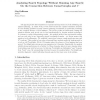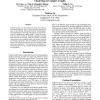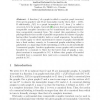376 search results - page 10 / 76 » Completely connected clustered graphs |
CONNECTION
2006
13 years 7 months ago
2006
Models of associative memory usually have full connectivity or if diluted, random symmetric connectivity. In contrast, biological neural systems have predominantly local, non-symm...
JAIR
2011
2011
Analyzing Search Topology Without Running Any Search: On the Connection Between Causal Graphs and h+
12 years 10 months ago
The ignoring delete lists relaxation is of paramount importance for both satisficing and optimal planning. In earlier work, it was observed that the optimal relaxation heuristic ...
DAM
2010
13 years 7 months ago
2010
We study P6-free graphs, i.e., graphs that do not contain an induced path on six vertices. Our main result is a new characterization of this graph class: a graph G is P6-free if an...
AAAI
2008
13 years 10 months ago
2008
Complex graphs, in which multi-type nodes are linked to each other, frequently arise in many important applications, such as Web mining, information retrieval, bioinformatics, and...
CSR
2008
Springer
13 years 9 months ago
2008
Springer
A function f of a graph is called a complete graph invariant if two given graphs G and H are isomorphic exactly when f(G) = f(H). If additionally, f(G) is a graph isomorphic to G, ...



